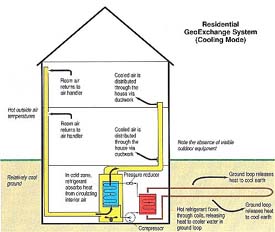Geothermal Heat Pump Diagrams
Geothermal Heat Pump Diagrams
What They Look Like

Residential Air Conditioner
If you were to visit a house that was equipped with geothermal heating and cooling, you would probably not notice any difference between it and a house with a standard heat pump. The largest difference is the absence of an exterior or outdoor compressor. This unit is often the source of noise complaints as the large fan draws vast quantities of air through the outdoor coil to extract and/or inject heat into the refrigerant coil in the outdoor unit. You can see the outdoor unit clearly in the diagram to the right.
The Loop
You already know that the geothermal systems use an outdoor loop. The illustration below show a very simplistic loop for the sake of showing a loop. There are different ways to install loops. They can be coils of tubing that lay on top of one another. They can be long runs of tubing that criss-cross in a large hole. They can also be vertical loops installed in vertical shafts in the soil.

Residential GeoExchange System
Your lot size, system type and load, and soil makeup will control the type of loop you will have installed. Don't try to engineer it yourself. Get two or three quotes or opinions and sort out what makes sense.
If you get conflicting opinions or designs, start to ask lots of questions. Write down the answers. Compare notes with each contractor and let them respond to the points. Above all, get WRITTEN installation instructions from the actual manufacturer before you sign a contract. Verify that the method proposed by the contractor conforms to what the manufacturer says. If you don't do this, you could have problems down the road!
Illustrations courtesy of the Geothermal Heat Pump Consortium
Column B262